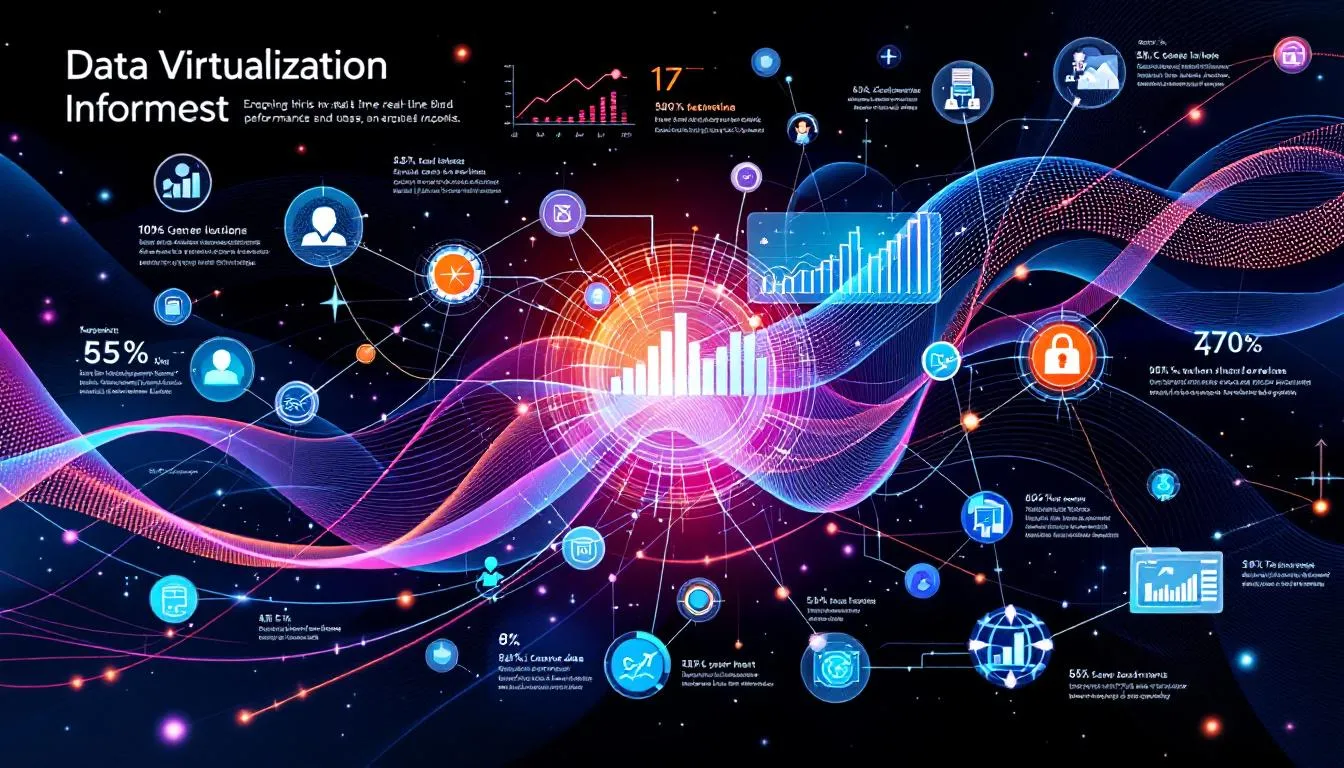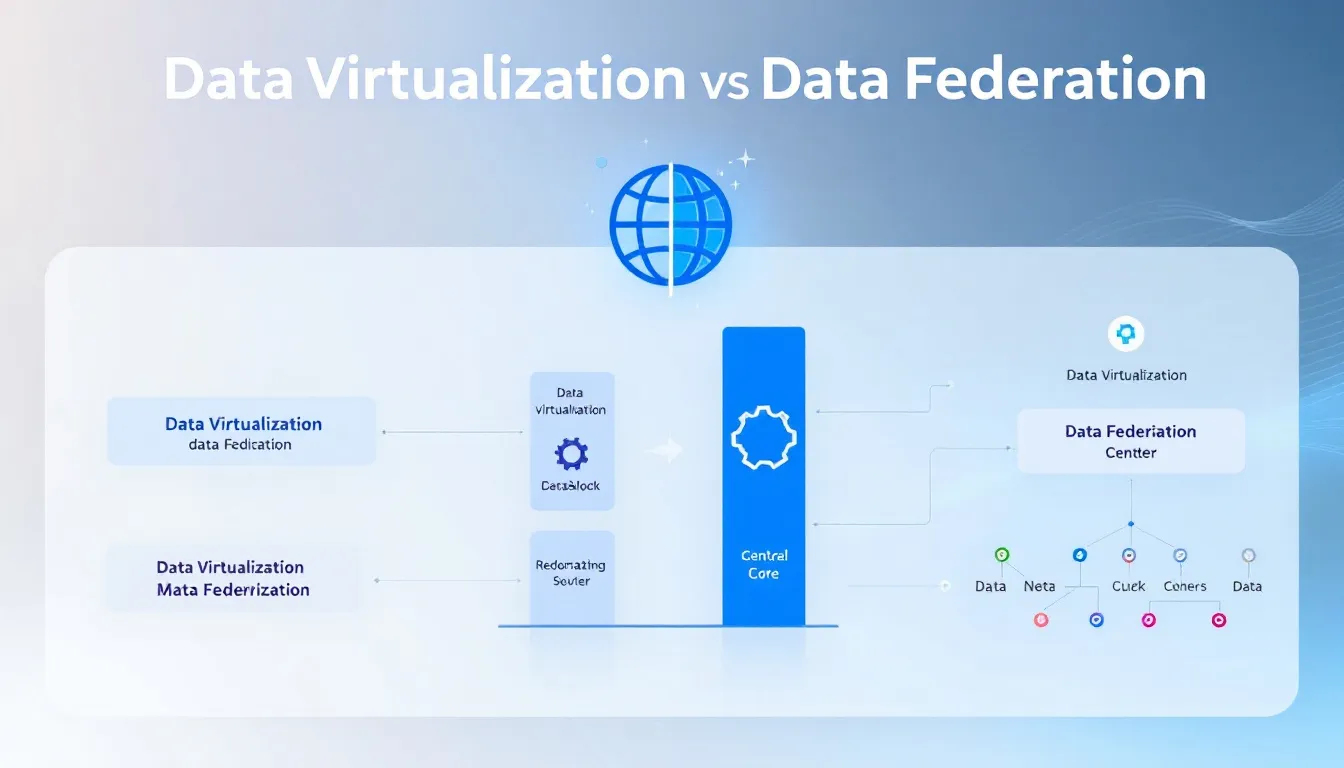Curious about data virtualization benefits? Data virtualization offers seamless access to data from various sources without complex integration. It brings real-time insights, boosts business agility, and cuts costs.
Explore how these benefits can transform your data management practices in this comprehensive guide.

Enhanced Data Accessibility

Data accessibility is crucial for effective data management, and data virtualization excels for data consumers by enabling:
-
Seamless access to data from multiple sources through a single virtual layer
-
Elimination of complex integration processes
-
Access to data without moving or duplicating it
-
Access to data stored in various databases, data lakes, and data warehouses as if they were all part of a single, cohesive system
-
Connection to a wide variety of data sources using native connectors, APIs, and drivers to extract and deliver data efficiently.
-
Seamless access to data from multiple sources through a single virtual layer
-
Elimination of complex integration processes
-
Access to data without moving or duplicating it
-
Access to data stored in various databases, data lakes, and data warehouses as if they were all part of a single, cohesive system.
Real-time data retrieval transforms how organizations make informed decisions. Tools supporting real-time access to scattered customer data ensure decision-makers have the latest insights at their fingertips, enhancing decision-making and fostering innovation. Additionally, these tools enable users to access data efficiently and store data effectively, providing real time data access for optimal performance.
Data virtualization benefits data consumers across the organization. A single data access layer allows employees to efficiently retrieve integrated data from various sources, improving data quality and consistency. This unified approach eliminates silos, paving the way for agile data management and better business intelligence outcomes, with data accessed more effectively. Additionally, it simplifies data access by masking technical details of the data sources, allowing non-technical users to access data effortlessly.
Improved Business Agility

In a rapidly changing business environment, agility is crucial. The flexibility data virtualization offers allows organizations to quickly adapt to new data sources and growing data demands. By minimizing physical data movement, it streamlines processes and enhances data accessibility, enabling swift responses to market changes. Additionally, data migration plays a vital role in ensuring that organizations can efficiently transition between systems. During mergers and acquisitions, data virtualization can streamline the data integration process by allowing data to stay in its original sources.
A key benefit of data virtualization is providing real-time access to enterprise data, enabling business users to make informed decisions quickly. This responsiveness is vital for maintaining a competitive edge. The logical data layer created by data virtualization software also increases access speed and efficiency, supporting agile data management practices. Real-time data access is crucial for making business decisions and delivering value to customers quickly.
Eliminating data silos and providing a unified view of data fosters a more agile and responsive business environment. This adaptability is crucial for leveraging big data platforms, big data analytics, and business intelligence tools, ultimately driving better outcomes and improved operational efficiency.
Cost Efficiency

Managing data can be costly, but implementing data virtualization offers a cost-efficient alternative to traditional methods. It reduces costs by minimizing the need for extensive data duplication and physical movement, allowing organizations to avoid the high costs associated with virtualized data warehousing.
Data virtualization eliminates the need for data replication, further reducing management costs. Streamlined data processes enhance operational efficiency and reduce redundancy, resulting in a more scalable and cost-effective data management strategy that adapts to changing business needs and incorporates data models.
The productivity boost from data virtualization translates into significant labor cost savings. Traditional data integration processes are often labor-intensive, but data virtualization simplifies these tasks, allowing data engineers and business users to focus on strategic activities. Improved productivity, combined with reduced infrastructure and operational costs, makes data virtualization a smart investment.
Real-Time Data Insights

In the age of big data, real-time access to updated information is crucial for timely decisions and responding to rapid changes. Utilizing data virtualization excels by providing real-time data insights through unified views of diverse data sources, including historical data allowing organizations to analyze data from multiple sources in real time, enhancing operational efficiency and speeding up decision-making. It also enables real-time integration of IoT data streams and other data sources, further enhancing its utility in dynamic environments.
Specialized data virtualization tools ensure real-time updates are available to all employees, promoting informed and efficient decision-making. This real-time access improves business intelligence and supports agile data management practices. By accessing and analyzing up-to-date data and utilizing data services, companies can stay ahead of the competition and drive innovation.
Integrating data from multiple sources into a single, coherent view, data virtualization eliminates silos that often hinder data analysis, especially when dealing with disparate data sources and disparate sources of heterogeneous data sources. This integrated approach ensures organizations can integrate data effectively, providing access to high-quality, consistent data, enabling better decisions and outcomes.
Centralized Data Governance and Security

Data governance and security are critical concerns for any organization, and data virtualization software acts by providing a robust framework for addressing these challenges. Key features include:
-
Centralized control over security enabling access management from a single point
-
Implementation of row and column-level security
-
Ensuring consistent data management policies across different sources
-
Integration with governance frameworks to ensure compliance with regulations such as HIPAA and GDPR
-
Real-time access to data while applying centralized governance and data masking.
-
Centralized control over security enabling access management from a single point
-
Implementation of row and column-level security
-
Ensuring consistent data management policies across different sources
-
Integration with governance frameworks to ensure compliance with regulations such as HIPAA and GDPR.
-
Centralized control over security enabling access management from a single point
-
Implementation of row and column-level security
-
Ensuring consistent data management policies across different sources.
The virtual data layer created by data virtualization maintains data consistency, security, and governance through centralized rules and policies. Robust access controls and security measures can be effectively enforced at the data virtualization layer, protecting sensitive information and ensuring compliance with data protection regulations. By providing a unified view of data from multiple sources, data virtualization enhances data security and compliance with regulations. This centralized security policy application ensures consistent access control and enhances overall data security. Additionally, data virtualization provides real-time access to data while applying centralized governance and data masking, ensuring sensitive information is protected while maintaining accessibility for decision-making. The virtual data layer also simplifies data retrieval and accelerates analysis, enabling faster decision-making while maintaining data governance and security.
Data virtualization provides secure access for audits and reporting, centralizing governance and ensuring compliance with regulatory requirements. Enhancing data security and compliance reduces the risks associated with data breaches and unauthorized access.
Scalability and Flexibility

Scalability and flexibility are essential for managing growing data demands, and data virtualization excels in these areas. A unified access layer enhances the ability to scale operations efficiently, allowing enterprises to easily scale and integrate new data sources without major infrastructure changes.
A key advantage of data virtualization is its ability to scale resources according to real-time demands. This flexibility ensures organizations can handle increasing data volumes and complexity without extensive system changes. Effective performance management supported by data virtualization is crucial for maintaining scalability.
By providing a scalable and flexible data management solution, data virtualization solutions enable organizations to adapt to changing business needs and leverage big data analytics more effectively. This adaptability is crucial for staying competitive in today’s fast-paced market.
Enhanced Collaboration Across Teams
Effective collaboration is vital for any organization’s success, and data virtualization enhances teamwork significantly. By enabling teams to access a unified view of data, it fosters collaborative decision-making and ensures all team members work with up-to-date information.
A key benefit of data virtualization is its ability to eliminate data silos, which often hinder collaboration. By providing real-time queries across large enterprises, it enhances collaboration and allows teams to work more effectively. The integration of diverse data sources through virtualization streamlines processes and promotes teamwork.
Breaking down data silos and providing a unified view of data supports agile data management and helps teams collaborate more efficiently. This enhanced collaboration leads to better decision-making and improved business outcomes.
Accelerated Time-to-Value
In the fast-paced business world, time is money, and data virtualization significantly shortens the time required to realize the value of data projects. Streamlining data processes and reducing project completion times lead to quicker project completion and improved return on investment (ROI).
Accelerated project completion enabled by data virtualization reduces costs and enhances efficiency in data management tasks. Faster realization of business value translates into quicker ROI cycles, increased revenue, and cost savings, making data virtualization an invaluable tool.
Increased Staff Productivity

A significant benefit of data virtualization is its impact on staff productivity. Reducing the time employees spend on data-related tasks allows staff to focus more on analytical and decision-making activities, leading to better business outcomes and higher employee satisfaction. The benefits of data virtualization extend beyond mere efficiency.
User-friendly data virtualization tools facilitate quicker training and onboarding of new employees, further enhancing data engineering productivity. Simplified data access and management allow employees to perform their tasks more efficiently and effectively. This productivity boost translates into significant labor cost savings and improved operational efficiency.
Eliminating data silos and providing a unified view of data from multiple sources and source systems supports better decision-making and more efficient data management practices. Enhanced productivity ultimately leads to better business outcomes and a more agile organization.

Factory Thread: Realizing the Full Potential of Data Virtualization in Manufacturing
While the benefits of data virtualization are vast, realizing them in a manufacturing environment requires a platform built with industry-specific challenges in mind. Factory Thread delivers exactly that—a robust data virtualization platform tailored for smart manufacturing.
Unified Access, Real-Time Operations
Factory Thread connects ERP, MES, CRM, and other systems into a seamless virtual data layer, enabling a 360° view of operations—without duplicating data. It supports real-time insights that empower faster, more informed decisions across production, quality, and business systems.
Low-Code, High-Impact Integration
With its drag-and-drop visual workflow builder and AI workflow assistant, Factory Thread slashes integration times from weeks to days. Engineers and analysts can build and deploy flows in minutes—no scripting required. This low-code flexibility empowers teams to respond quickly to changes without relying heavily on IT resources.
Scalable and Secure
Factory Thread’s architecture supports deployment on cloud, on-prem, or edge environments with enterprise-grade encryption and centralized governance. Whether scaling across global sites or ensuring compliance with standards like HIPAA and GDPR, Factory Thread keeps your data secure and operations agile.
Built for the Future of Manufacturing
Factory Thread offers plug-and-play connectors for Siemens Opcenter, SQL databases, REST APIs, and more, ensuring quick onboarding and extensibility. Its unified monitoring and real-time data access ensure that insights are always at your fingertips—driving innovation, reducing costs, and improving productivity.
By aligning precisely with the data virtualization principles outlined above, Factory Thread makes those benefits tangible and scalable for modern manufacturers.
Summary
Summarizing the key points, data virtualization offers numerous benefits that transform how organizations manage and utilize their data assets. From enhanced data accessibility and improved business agility to cost efficiency and real-time insights, data virtualization provides a comprehensive solution for modern data management challenges. Additionally, centralized data governance, scalability, enhanced collaboration, accelerated time-to-value, and increased staff productivity further highlight the transformative power of data virtualization.
As organizations continue to navigate the complexities of the digital age, embracing data virtualization is not just a smart choice—it’s a necessity. By leveraging the benefits of data virtualization, businesses can drive innovation, improve operational efficiency, and achieve better outcomes.
Frequently Asked Questions
What is data virtualization?
Data virtualization is a technology that enables seamless access to integrated data from multiple sources through a unified virtual layer, facilitating real-time insights without the necessity for physical data movement. This approach enhances efficiency and decision-making across organizations.
How does data virtualization improve business agility?
Data virtualization enhances business agility by allowing organizations to rapidly integrate new data sources and access real-time information, thereby facilitating more responsive decision-making and efficient data management. This capability ultimately helps businesses stay competitive and adapt to changing market demands.
What are the cost benefits of data virtualization?
Data virtualization offers substantial cost benefits by reducing infrastructure expenses through the elimination of data duplication and physical movement, while also avoiding costly data warehousing solutions, ultimately enhancing operational efficiency and driving significant savings.
How does data virtualization enhance collaboration across teams?
Data virtualization enhances collaboration across teams by offering a unified view of data, which eliminates data silos and ensures all members have access to real-time information for informed decision-making.
What impact does data virtualization have on staff productivity?
Data virtualization significantly enhances staff productivity by minimizing the time spent on data-related tasks, enabling employees to concentrate on analytical and decision-making activities. This ultimately results in improved business outcomes with better data models .
Share this
You May Also Like
These Related Stories

Data Virtualization vs Data Lake: Making the Right Choice for Your Business

Data Virtualization vs Data Federation


No Comments Yet
Let us know what you think